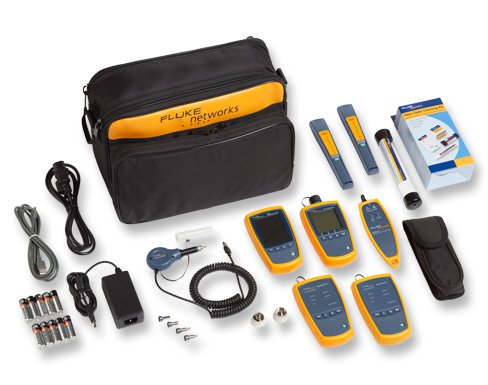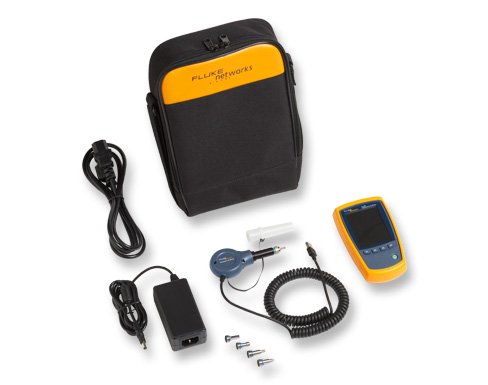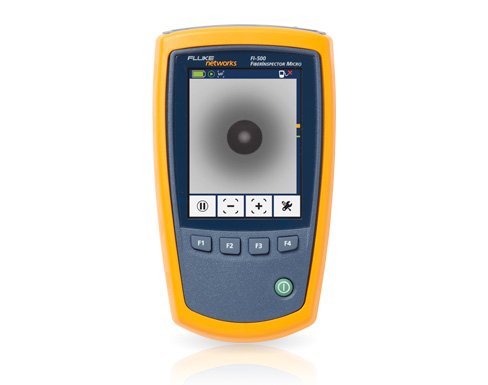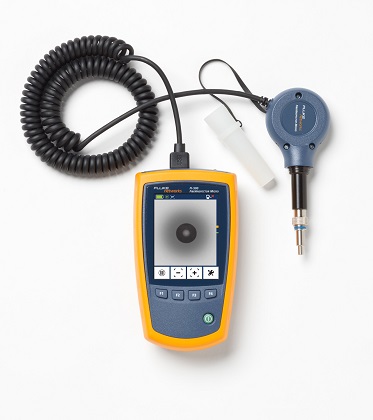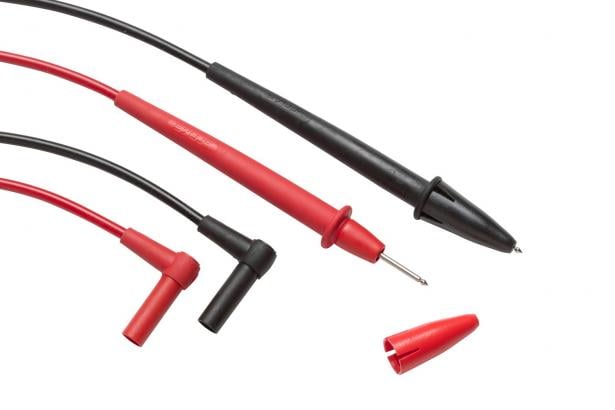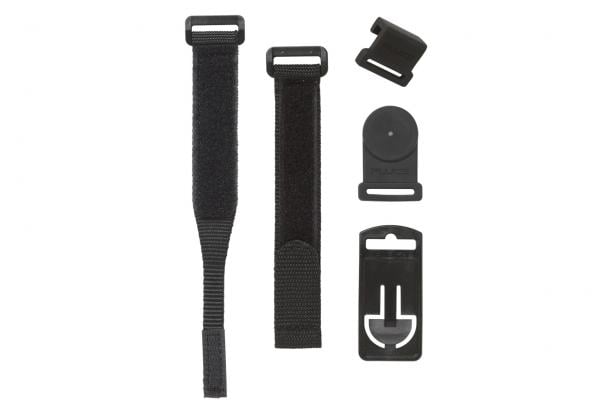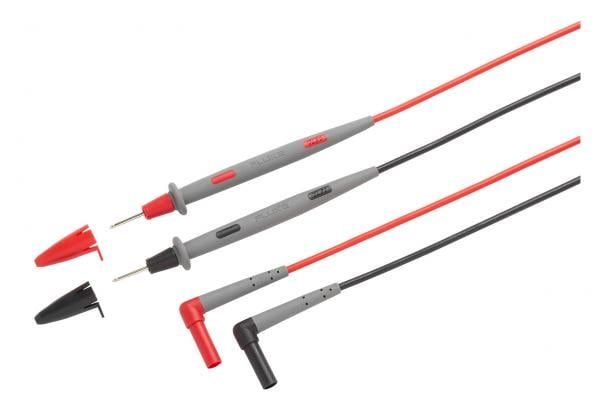FI-500 FiberInspector™ Micro Fiber Scope Camera
Key Features
PortBright™ Illumination and Compact Probe Design
Fiber panels are often densely packed with fibers and small LC connectors. It can be difficult to see the port of interest without having extra lighting. You can use a separate flashlight, but then you need to hold more items or have a helper hold the flashlight. PortBright is a flashlight that is built into the probe and allows you to find the port and then connect the probe tip. PortBright is activated by a button on the probe itself.
The probe is only 23mm (0.95") wide and 51mm (2") thick which makes it easier to get into tight patch panels with less disruption of nearby fibers.
Autofocus and Autocenter
All manual scopes and many digital probes have manual focus rings. This may require two hands and is sometimes difficult to focus in densely packed patch panels. FI-500 can auto-focus with the push of a button on the probe or on the display unit. Autofocus takes only 3-5 seconds and works great on UPC end faces.
Autofocus works on APC (angled physical contact) also, however, if the APC tip is not aligned with the connector, the connector or probe may require rotation and repeating auto-focus or manual focus.
The autocenter feature activates as soon as you pause the image. The FI-500 will orient the fiber ferrule directly in the center of the screen as well as initiate autofocus. This allows the user to inspect the fiber core easily without having to manually manipulate the fiber.
Cleaning Kits
An important addition to your verification, troubleshooting, and inspection tasks is fiber cleaning. Dirt, dust, and other contaminants are the enemy of high-speed data transmission over optical fiber. Today's network applications require more bandwidth, making loss budgets tighter than ever. It is critical that all optical connections are clean and free of contaminants to ensure application success.
Fluke Networks Fiber Optic Cleaning Kits have the best tools to effectively remove the toughest contaminants with ease.
FI-525 Fiber Cleaning and Inspection Kit Includes FI-500; complete cleaning supplies (cleaning cube, ten cleaning cards, solvent pen, 2.5 mm port cleaning swabs, and 1.25 mm port cleaning swabs) and soft carrying case.
NFC-KIT-BOX
The Fiber Optic Cleaning Kit includes a cleaning cube with wipes, five cards with sealed cleaning zones, a solvent pen, and 2.5mm port cleaning swabs.
NFC-KIT-CASE
Fiber Optic Cleaning Kit includes a cleaning cube with wipes, ten cards with sealed cleaning zones, a solvent pen, 2.5 mm port cleaning swabs, and 1.25 mm port cleaning swabs in a rugged carrying case.
Wide Variety of UPC and APC Probe Tips
14 tips are available to address almost any port or connector configuration.
4 UPC tips are included (SC, LC, 1.25 mm, and 2.50 mm). Each of these can be ordered separately if you lose one and there are also ST and FC tips.
FI-500-TP-APC is a kit of four APC (angled physical contact) tips in a convenient case - SC, LC, 1.25 mm, and 2.50 mm. An FC APC tip is also available.
There is also a 46 mm UPC LC bulkhead extender tip.
Fiber Inspection, Power, and Cleaning Kits
Fiber Inspection and Cleaning Kit (FI-525)
FI-500 FiberInspector Micro and wet and dry cleaning supplies to remove contamination discovered during fiber inspection with the FI-500. Kit includes: FI-500, NFC-KIT-BOX, and 1.25 mm swabs.
Complete Fiber Verification Kit (FTK1475)
The Complete Fiber Verification Kit is for contractors and network technicians who install and maintain premises networks with both multimode and single-mode optical fiber. Use this kit to verify optical loss and power levels at 850, 1300, 1310, and 1550 nm, inspect fiber end-faces, and locate cable faults, connector problems, and polarity issues. Kit includes FI-500 FiberInspector Micro.
Full-Featured Inspection and Multimode Verification Kits (FTK1375)
The Full-Featured Inspection and Multimode Verification Kits are for contractors and network technicians who install and maintain multimode premises networks. Use these kits to verify optical loss and power levels at 850 and 1300 nm, inspect fiber end-faces, and locate cable faults, connector problems, and polarity issues. Kit includes FI-500 FiberInspector Micro.
- • PortBright™ illumination helps you see ports in dark and dense panels.
- • Autofocus provides a stable image in a few seconds.
- • Large display shows single-mode and multimode fiber end faces.
- • Includes 4 UPC tips (LC, SC, 1.25 mm, and 2.50 mm), with APC and bulkhead tips available.
Dirty fiber optic end faces are the major cause of problems in single-mode and multimode fiber optic systems. The FI-500 FiberInspector™ Micro fiber optic scope camera removes the hassle associated with inspecting fiber end faces, especially in low light and high cable density situations.
Simply plug the cable into the FI-500 and touch the AF button. Within seconds, the fiber end face comes into sharp, clear view. And if you're working in a difficult-to-reach place or you can't get the image to stand still, just touch the pause button to freeze the image.
What is a fiber optic scope?
A fiber optic scope (also called a fiber optic inspection scope or fiber optic scope camera) is a device specifically designed for inspecting the end faces of fiber optic connectors. These inspections are critical for preventing problems in fiber optic cabling systems, as even minor damage or contamination can impact network performance significantly.
How do fiber optic scopes work?
Fiber optic scopes operate by magnifying the image of a fiber optic connector’s end face, allowing a technician to inspect it for cleanliness and integrity. These scopes typically include a camera or a microscope-style eyepiece for viewing. Advanced models often feature autofocus and illumination capabilities to make viewing easier in a variety of environments. The image captured by the scope can be displayed on a screen for detailed examination — which avoids potential eye damage from looking into a live fiber with an optical scope.
The key function of a fiber optic scope is to identify and highlight any contamination, such as dust or oils, and physical damage, like scratches or chips on the end face. These defects can impede the performance of the fiber optic network by causing loss and reflectance. inspection with a fiber optic scope is crucial any time a connection is made to maintain the high performance of fiber networks, since even minor defects can have significant impacts on signal transmission.
What is the biggest advantage of fiber optics?
The single biggest advantage of fiber optics for networks is its high bandwidth capacity, which is crucial in modern network environments, where demand for faster transmission speeds is continually increasing. Fiber optics allow for significantly faster data transmission speeds compared to traditional copper cabling and are immune to the electromagnetic interference that can affect their copper counterparts. Fiber optic cables are also smaller and lighter than their copper counterparts; they boast an extended reach of up to over 100 kilometers (compared to copper’s 100 meters), making them ideal for extensive installations like large commercial buildings and data centers.
Why is inspecting fiber optic cabling difficult?
For all fiber’s advantages, today's high-density fiber patch panels make inspection a challenge. Finding the cable or port to test can be tough, especially in the low light conditions found in most data centers and wiring closets.
Manual inspection scope cameras are simple to use, but they don’t work well on patch panels or where there’s a high density of fiber. Fully automatic fiber optic inspection scopes can analyze and grade the cleanliness of fiber connections, but their advanced analytic capabilities aren’t usually needed for quick, basic troubleshooting.
The FI-500 simplifies the inspection process. Its built-in PortBright flashlight helps you find the right port or cable. The small-profile probe fits into tight spots and features push-button controls for simple operation. Its autofocus camera provides a sharp view of the end face in a few seconds, while its pause button freezes the image on the crisp 320 x 240 display for more detailed inspection.
The FI-500 FiberInspector Micro fills the gap between a manual scope and a fully automated fiber optic inspection scope: it has the simplicity and practicality of a manual tool, plus advanced features that reduce troubleshooting and inspection time.
| General Specifications | |
| Temperature range without the power adapter | Operating: 0 °C to +50 °C |
| Storage: -30 °C to +60 °C | |
| Temperature range with the power adapter | Operating: 0 °C to +40 °C |
| Storage: -20 °C to + 60 °C | |
| Humidity range | Operating: 0% to 95% °C (0 °C to +50 °C) RH non-condensing |
| Storage: 0% to 95% (35 °C to 45 °C) RH non-condensing | |
| Altitude | Operating: 4,000 meters |
| Storage: 12,000 meters | |
| Vibration | 2 g, 5 Hz to 500 Hz |
| Shock | 1 meter drop test |
| Safety | IEC 61010-1 3rd Edition IEC 62133 |
| Display | |
| Magnification | 1x, 2x, 4x |
| Frames per second | ≥12 |
| Battery type* | Rechargeable NiMH, 2 x 1.2V, 2700 mAh |
| Battery life* | 3 hours of continuous probe use |
| 6 hours of typical probe use | |
| Charge time | 4 hours minimum |
| Power adapter | Input: 100 to 240 VAC±10%, 50/60Hz |
| Output: 6 VDC, 3 A maximum Class | |
| Display | 3.2 inch TFT LCD, 320 x 240 |
| Software upgrades | Upgrades can be installed from a USB drive |
| Input | USB 2.0, Type A |
| Dimensions | 5.5 in x 3.2 in x 1.5 in (140 mm x 80 mm x 39 mm) |
| Weight | 9.7 oz (275 g) |
| *Tested using Gold Peak GH230AAHC batteries. | |
| *Tested using Gold Peak GH230AAHC batteries. | |
| Probe | |
| Magnification | 200x. Zoom function has 1x, 2x and 4x settings |
| Camera type | 5 Megapixel 1/4-inch CMOS sensor |
| Field of view | 610 μm x 460 μm |
| Resolution | 1 μm |
| Light source | LED, >100,000 hr life |
| Endface illumination | Coaxial blue LED |
| Port illumination | 2 white LEDs |
| Power | Supplied through the USB interface |
| Output | Video output through USB 2.0 interface |
| Dimensions | 4.6 in x 2 in x 0.95 in (117 mm x 51 mm x 23 mm) (length depends on adapter tip) |
| Weight | 4.4 oz (125 g)(with no adapter tip) |
| Models | |
| FI-500 | |
| FiberInspector Micro with Probe, Display, 4 UPC tips (LC bulkhead, SC bulkhead, 1.25mm end face adapters and 2.50mm end face adapters), Magnetic strap attachment, case, rechargeable batteries and universal power adapter See Photo | |
| FI-500 | |
| FI-500 Gold Support | GLD-FI-500 |
| 1 year of Gold Support for FI-500 | |
| GLD3-FI-500 | |
| 3 years of Gold Support for FI-500 | |
| FI-525 | |
| FiberInspector Micro and Cleaning Kit (NFC-KIT-BOX), Magnetic strap attachment, and 1.25 mm swabs See Photo | |
| FI-525 | |
| FI-525 Gold Support | GLD-FI-525 |
| 1 year of Gold Support for FI-525 | |
| FTK1375 | |
| FI-500 with SimpliFiber Pro Multimode PMLS kit, VisiFault, Magnetic strap attachments and 2 FindFibers See Photo | |
| Learn more about Fluke Premium Care – Gold | |
| FTK1375 Gold Support | FTK1375 |
| GLD-FTK-1375 | |
| 1 year of Gold Support for FTK-1375 | |
| FTK1475 | |
| FI-500 with SimpliFiber Pro Multimode & Singlemode PMLS, VisiFault, 2 FindFibers, Magnetic strap attachments, Cleaning kit (NFC-KIT-BOX) and 1.25 mm Swabs See Photo | |
| Learn more about Fluke Premium Care – Gold | |
| FTK1475 Gold Support | FTK1475 |
| GLD-FTK-1475 | |
| 1 year of Gold Support for FTK-1475 | |
| FI-500TP-APC | Set of 4 Angled Physical Contact Tips (LC bulkhead, SC bulkhead, 1.25mm end face adapters and 2.50mm end face adapters) |
| NFC-KIT-BOX | Fiber Optic Cleaning Kit - Includes cleaning cube with wipes, five cards with sealed cleaning zones, solvent pen and 2.5 mm port cleaning swabs. |
| Accessories | |
| FI-500TP-STF | ST fiber bulkhead connectors |
| FI-500TP-SCF | SC bulkhead fiber connectors |
| FI-500TP-FCF | FC bulkhead fiber connectors |
| MS2-MAG-KIT | Magnetic Strap Attachment and spare holster |
Product Highlights
Fiber Inspection Scope Camera to verify that fiber end faces are not contaminated or damaged.
- PortBright™, a built-in flashlight, illuminates dark areas and dense panels.
- Fiber inspection scope camera with autofocus for stable images in a few seconds.
- Large display to view single-mode and multimode fiber end faces.
- Includes 4 UPC tips (LC, SC, 1.25 mm, and 2.50 mm). APC, Bulkhead tips available.





